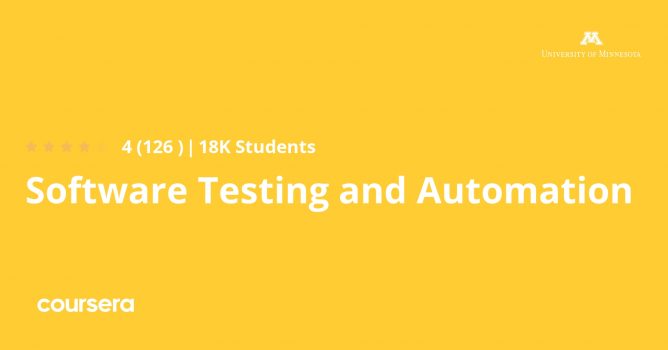After completing Software Testing and Automation Specialization, you will be able to…
- Understood the difference between verification and validation.
- Explain the goal of testing.
- Use appropriate test terminology in communication; specifically: test fixture, logical test case, concrete test case, test script, test oracle, and fault.
- Understood the motivations for white and black box testing.
- Compare and contrast test-first and test-last development techniques.
- Measure test adequacy using statement and branch coverage.
- Reason about the causes and acceptability of and poor coverage
- Assess the fault-finding effectiveness of a functional test suite using mutation testing.
- Critique black-box and white-box testing, describing the benefits and use of each within the greater development effort.
- Distinguish among the expected-value (true), heuristic, consistency (as used in A/B regression), and probability test oracles and select the one best-suited to the testing objective.
- Craft unit and integration test cases to detect defects within code and automate these tests using JUnit.
- You will gain an understanding of the theory of testing.
- You will practice writing tests for a variety of quality intent, including code coverage, defect finding, and statistical testing.
- You will develop test plans to guide the testing stage of the software development lifecycle.
- You will create defect reports to provide transparency and understanding to supervisors, colleagues, and users.
- Models of testing and types of systematic testing strategies
- Social aspects of testing
- Learn about test plans, testing status reports, and defect reporting
- Software Defect Reports Analysis & Reporting
- Learn about writing unit tests
- Test Doubles Input & Output
- You will evaluate testability of requirements
- You will define testable units within a program specification
- You will select and apply black-box test input selection methods, including boundary-value analysis, fuzzing, and random selection
- You will develop automated tests and test oracles for automated software verification
- Evaluate testability of requirements
- Testable units within a program specification
- Apply black-box test input selection methods – specifically boundary-value analysis, fuzzing, and random selection – and select the method most-suited to achieve the given testing objective
- Assess the fault-finding effectiveness of a functional test suite using mutation testing
- Use category partitioning to develop automated functional tests (with Cucumber) based on a given software specification
- Create an expected-value oracle from a program description to use within the generated tests
- Learn about the basics of testing adequacy
- Black and White-box Techniques
- Installing Cucumber and Configuring Eclipse Project
- Understand the foundations of automated verification: randomization and symbolic representations
- Distinguish the strengths and weaknesses of random testing, symbolic analysis, static analysis, and model checking
- Use a variety of state-of-the-art static analysis and automated testing tools for automated verification
- Create executable requirements as an oracle suitable for automated testing and symbolic analysis
- Understand how the choice of oracle affects fault-finding for automated analysis strategies.
- Use automated testing to achieve full mutation coverage
- Create a test plan that utilizes both manually-written tests and automated tests towards maximizing rigor, minimizing effort and time, and minimizing test costs.
- How to specify properties of interest to check about a program
- How to capture assumptions about the environment for effective testing
- Automated Test Generation using Random Testing
- Automated Test Generation using Symbolic Execution
- Automated Test Generation using Metaheuristic Search
- What is Static Analysis
- Automating Security Testing Using Fuzz Testing
Software Testing and Automation Specialization includes 4 Courses they are
- Introduction to Software Testing
- Black-box and White-box Testing
- Introduction to Automated Analysis
- Web and Mobile Testing with Selenium
Course Instructor Sanjai Rayadurgam, Kevin Wendt, Mike & Offered by University of Minnesota from Coursera
Course Duration: Approximately 4 months to complete (Suggested pace of 6 hours/week)
Course is for Intermediate Level
Can I download Software Testing and Automation Specialization course?
You can download videos for offline viewing in the Android/iOS app. When course instructors enable the downloading feature for lectures of the course, then it can be downloaded for offline viewing on a desktop.Can I get a certificate after completing the course?
Yes, upon successful completion of the course, learners will get the course e-Certification from the course provider. The Software Testing and Automation Specialization course certification is a proof that you completed and passed the course. You can download it, attach it to your resume, share it through social media.Are there any other coupons available for this course?
You can check out for more Udemy coupons @ www.coursecouponclub.com
Note: 100% OFF Udemy coupon codes are valid for maximum 3 days only. Look for "ENROLL NOW" button at the end of the post.
Disclosure: This post may contain affiliate links and we may get small commission if you make a purchase. Read more about Affiliate disclosure here.
Disclosure: This post may contain affiliate links and we may get small commission if you make a purchase. Read more about Affiliate disclosure here.


